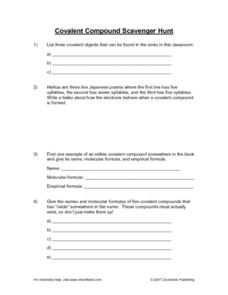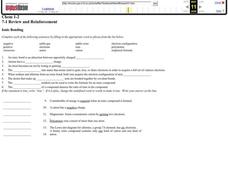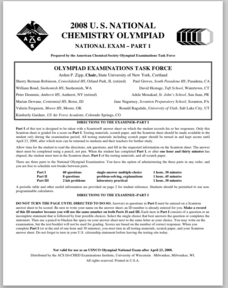Virginia Department of Education
Vapor Pressure and Colligative Properties
Hate to vacuum, but enjoy using a vacuum pump? Explore a lesson plan that starts with a demonstration of boiling water at various temperatures by using a vacuum pump. Then scholars design their own experiments to measure vapor pressure...
University of Georgia
The Power of Peanuts
Measure the amount of energy in a peanut by igniting a chemical reaction. Classes use a laboratory setup to burn a peanut and measure the amount of heat it releases through a temperature analysis. They calculate the number of Joules of...
Royal Society of Chemistry
Forensic Tests
Flame tests determine if there is a specific metal in a chemical compound. Young forensic scientists review their understanding of flame tests and hydroxide precipitates by solving puzzles. The timed review encourages mastery.
Curated OER
Reading Comprehension Worksheet: Compounds & Elements
In this reading comprehension worksheet, students read several short paragraphs about compounds and elements and then answer several questions about the text.
Curated OER
Balancing Equations
Students work in pairs to complete a worksheet that asks them to balance several chemical equations. They partner with other students to correct the equations and then follow online instructions to create a table in Word.
Curated OER
Chemical Compounds
In this chemical compounds worksheet, students identify the types of intermolecular forces present in the given substances, calculate the heat required to convert a liquid to gas, and explain the ideal-gas law. This worksheet has 5...
Curated OER
A Potpourri of Thermo Questions
In this thermodynamics worksheet, learners match terms to their definitions such as enthalpy, equilibrium, bond energy, and heat capacity. This worksheet has 20 words to match.
Curated OER
Review for Chemistry
In this review for chemistry learning exercise, students decide if given statements are true or false. Students relate information learned about introductory knowledge gained in chemistry to accurately answer the given questions.
Curated OER
Kinetics Challenge Problem
In this kinetics worksheet, students use date from two experiments to determine the reaction order, calculate the rate constant and activation energy, and predict the mechanism for the reaction. This worksheet has 7 problems to solve.
Curated OER
Recognizing Polar Molecules
For this polar molecules worksheet, students complete a graphic organizer by writing in the bond type, electron dot diagram, and the type of compound for the chemical compounds given.
Curated OER
Hybridization
In this chemical compounds worksheet, students draw the Lewis structure and "cloud" structures for given compounds. Then students match the Lewis structure with the correct cloud diagrams. This worksheet has 2 problems to solve.
Curated OER
Lewis Structures
In this Lewis structures worksheet, students identify and describe what Lewis structures or dot diagrams are and how they illustrate the valence electrons in an outer shell. Then they use a periodic table to determine the numbers of...
Curated OER
Endothermic or Exothermic Reactions
In this chemical reaction instructional activity, students determine if given reactions are endothermic or exothermic reactions. Students determine the energy released or consumed when chemical reactions occur. This instructional...
Curated OER
Biologically Important Molecules
In this biologically important molecules learning exercise, students fill in the blank with information about carbohydrates, lipids, and proteins. Students also make notes about nucleic acids.
Curated OER
Covalent Compound Scavenger Hunt
In this chemistry worksheet, students look for the covalent compounds while examining the objects in the classroom. They also apply the knowledge of formulas.
Curated OER
How Do Atoms Stick Together?
In this chemical bonding worksheet, learners answer 76 questions about compounds, Lewis dot structures, intermolecular forces between atoms, electronegativity and bonding and types of bonds.
Curated OER
Periodic Table
In this periodic table activity, students are given 12 terms and must match the terms to their appropriate definition. Topics include types of bonds, types of elements, and types of ions.
Curated OER
More Thermochemistry Problems
This two-page assignment covers basic thermochemistry concepts. Chemistry learners identify exothermic and endothermic processes, explain a phase change graph, and draw an energy level diagram. There are no problems to solve, just...
Curated OER
Ionic Bonding
In this ionic bonding worksheet, students review the characteristics of ionic bonding, draw Lewis dot diagrams for elements, and write the chemical formula for ionic compounds. This worksheet has 8 drawings, 14 fill in the blank, and 6...
Curated OER
Chemical Compounds
In this chemical compounds learning exercise, students write the name of compounds from their chemical formula, balance equations, write electronic configurations for elements, and draw Lewis dot structures. This learning exercise has 8...
Curated OER
Unit 4 - Periodic Table
There are 17 multiple choice questions on this periodic table test. The focus is on properties of the elements by group and period. The exam is not formatted well, making it a little difficult to read. There is also a typographical...
Curated OER
2008 U.S. National Chemistry Olympiad Part I
In this chemistry Olympiad worksheet, students solve sixty multiple choice questions on a variety of chemistry topics from finding molarity of solutions to calculating products of reactions. Students are given graphs, equations, reaction...
Curated OER
2008 U.S. National Chemistry Olympiad Part III
In this chemistry olympiad lab worksheet, chemists are required to design two experiments. In one, they design an experiment to identify seven solutions given to them in pipettes. In the other, they design an experiment to determine the...
Curated OER
2004 U.S. National Chemistry Olympiad - Local Section Exam
In this National Olympiad exam worksheet, chemistry apprentices answer sixty multiple choice questions including general chemistry topics such as atomic structure, gases, problem solving, writing and balancing equations and solutions....

























